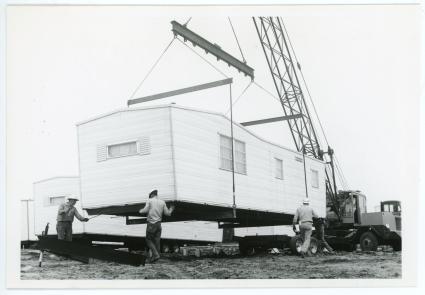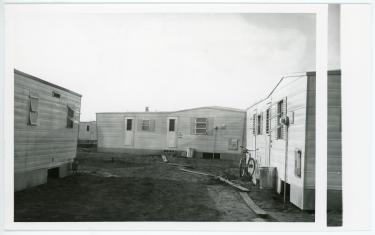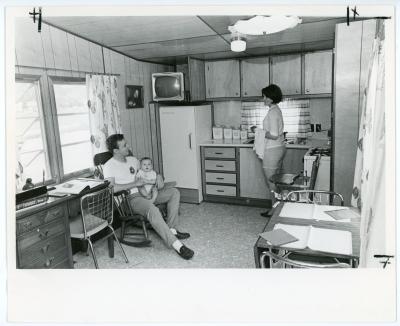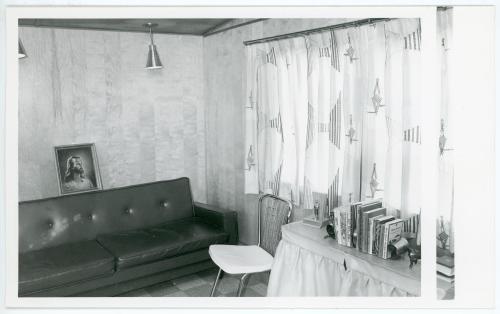Following World War II, the Iowa State Teachers College experienced a continuing demand for married student housing. The immediate postwar response was the construction of Sunset Village, consisting of seventy-two surplus military corrugated steel buildings that accommodated 144 families. Some of those metal buildings appear in the foreground of the photo at the head of this article. Those temporary buildings were meant to last five years, but ended up being used for twenty-five years. The next response was College Courts, built between 1956 and 1959. These were substantial structures that were used as family housing until they were demolished in 2011, but they accommodated only forty-eight families.
 By the early 1960s, the college clearly needed more family housing, but the level of bonded indebtedness of the dormitory system did not allow for the construction of further permanent units. Consequently, in March 1961, the Board of Regents considered a request for $200,000 to purchase fifty trailers for use as family housing. Some objected that the trailers would be unsightly and short-lived. They believed that the proposed $45 per month rent could not amortize the cost of the trailers within their useful lifespans. But in September 1962, the Regents approved a bid of $127,240 from Hilton Mobile Homes of Guttenberg, Iowa, for fifty trailers. The two bedroom units would be 38 X 10 feet, they would vary in color, and they would be placed on permanent foundations.
By the early 1960s, the college clearly needed more family housing, but the level of bonded indebtedness of the dormitory system did not allow for the construction of further permanent units. Consequently, in March 1961, the Board of Regents considered a request for $200,000 to purchase fifty trailers for use as family housing. Some objected that the trailers would be unsightly and short-lived. They believed that the proposed $45 per month rent could not amortize the cost of the trailers within their useful lifespans. But in September 1962, the Regents approved a bid of $127,240 from Hilton Mobile Homes of Guttenberg, Iowa, for fifty trailers. The two bedroom units would be 38 X 10 feet, they would vary in color, and they would be placed on permanent foundations.
In April 1963, Dennis Jensen, later Director of Financial Aid, announced that the trailers would be available in the summer of 1963. All rooms, except for one bedroom, would be furnished. A model trailer would be available for inspection. Rent would be $45 per month, and tenants would pay for utilities. Preference would be given to families with children.
By June 12, 1963, twenty-seven units were occupied, with the remaining twenty-three units to be installed yet that summer. The total cost of the project, including landscaping, roads, and sidewalks, was reported as $174,950. Early in the spring of 1964, the Student League Board donated money for a playground for children living in Sunset Village and South Courts.
The Board of Regents apparently regarded South Courts as a good solution to the married student housing problem. In December 1966, the Board approved $240,000, supported by the Dormitory Improvement Fund, for the purchase of fifty more trailers. These units were to be available for occupancy by September 1967. Rent for these units was to be $55 per month and $50 per month for the older units. The Regents also approved $15,000 for sidewalks in South Courts.
By November 1975, there began to be serious discussion of the fate of South Courts. Half of the trailers were nine years old; half were thirteen years old. At least the older units seemed to be approaching the end of their useful life. One had burned, one had been abandoned due to its condition, and two required more repairs than they were worth. There was still considerable pressure on the University to provide housing for married students. An architect drew up a study on the replacement of the capacity of the South Court units. A foregone conclusion seemed to be developing that new trailers, for reasons of aesthetics, lifespan, wind hazards, and site terrain, would not be considered. As Director of Planning Leland Thomson said, "An 'austerity' design is implied in the rental price, but should not result in sloppy construction . . . our goal is to provide standard housing accommodations at rental rates that our students can afford."
In March 1976, the Regents commissioned a married student housing master plan contract, not to exceed $31,500, to study site development, grading, building schematics, walks, and utilities for three hundred housing units. The architect was to study all housing options--from trailers to permanent units--and to compare costs of construction, operations, and energy use of the various options. At that time UNI offered 425 units of married student housing: 278 in Hillside Courts, 48 in College Courts, and 99 in South Courts. Board of Regents Executive Secretary Wayne Richey wanted UNI to bring its accommodations for married students up from 20% of enrolled married students to 30%.
Work began in the spring of 1977 on forty more Hillside Courts units. Housing administrator Jan Hollins said that UNI would "be gradually decommissioning our older 1963 model trailers . . . we will maintain the trailers as long as we can to provide low cost housing for summer students and those who can't afford to pay for renting other married housing units." In April 1978, the Regents passed a resolution allowing UNI to abandon the forty-nine remaining 1963 trailers. At that point some were already out of service and others were increasingly hard to maintain. The Regents resolution allowed the university to sell the units when they became irreparable. Later in 1978, when the forty new Hillside Courts were available for occupancy, the university began to look for ways to replace the 1967 trailers. But no clear solution emerged. In November 1981, Mr. Hollins said, "We are phasing out South Courts because, as rental properties, they have well fulfilled their objectives. Apartments are more practical and they are more in demand than mobile homes." Rent at that time was $96 per month in South Courts.
The Northern Iowan reported in the spring of 1982 that the last of the trailers would be removed yet that summer.
Compiled by University Archivist Gerald L. Peterson, with scanning by Library Assistant Gail Briddle, September 2002; last updated, March 21, 2012 (GP); photos and citations updated by Graduate Assistant Eliza Mussmann April 5, 2023.



